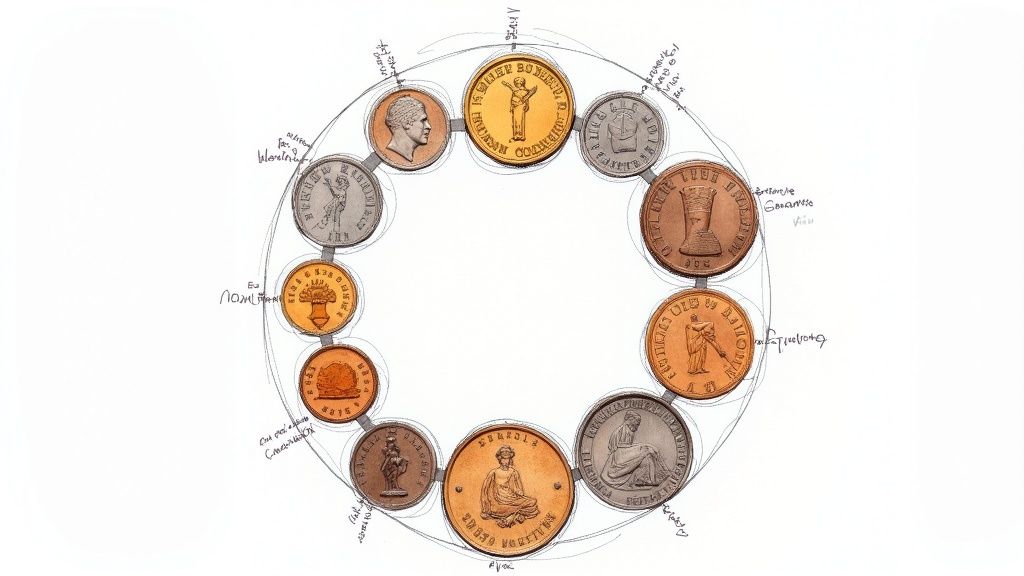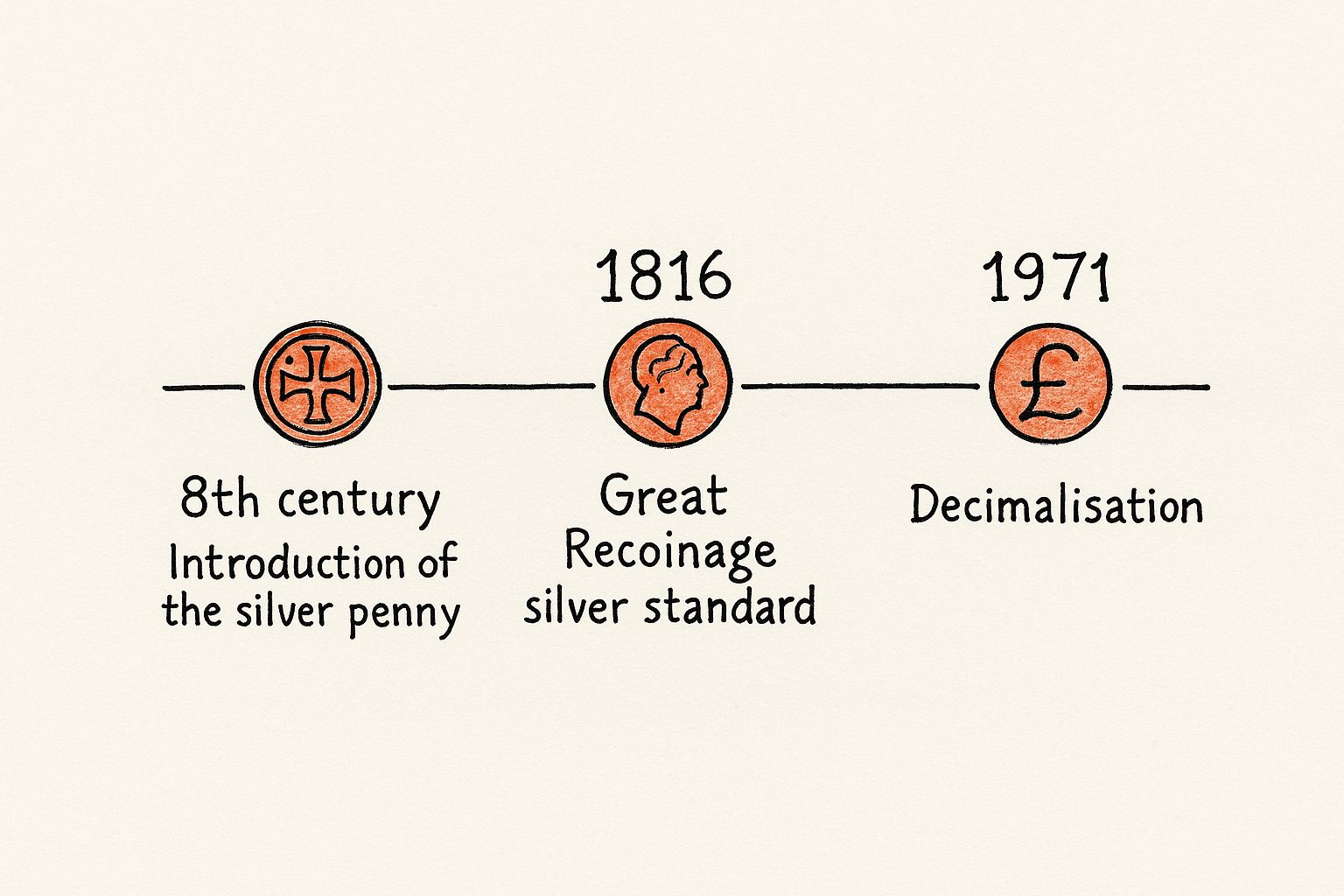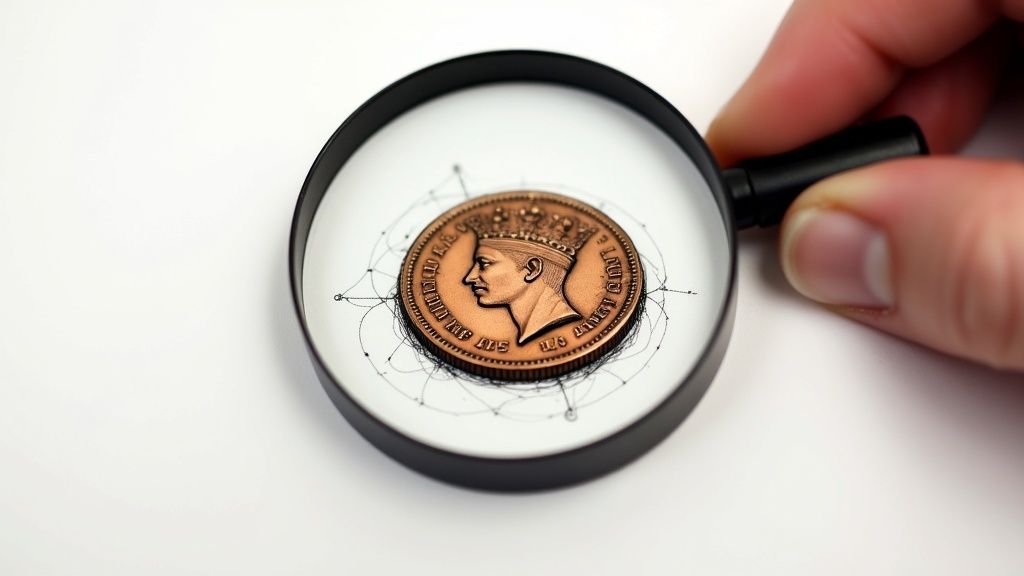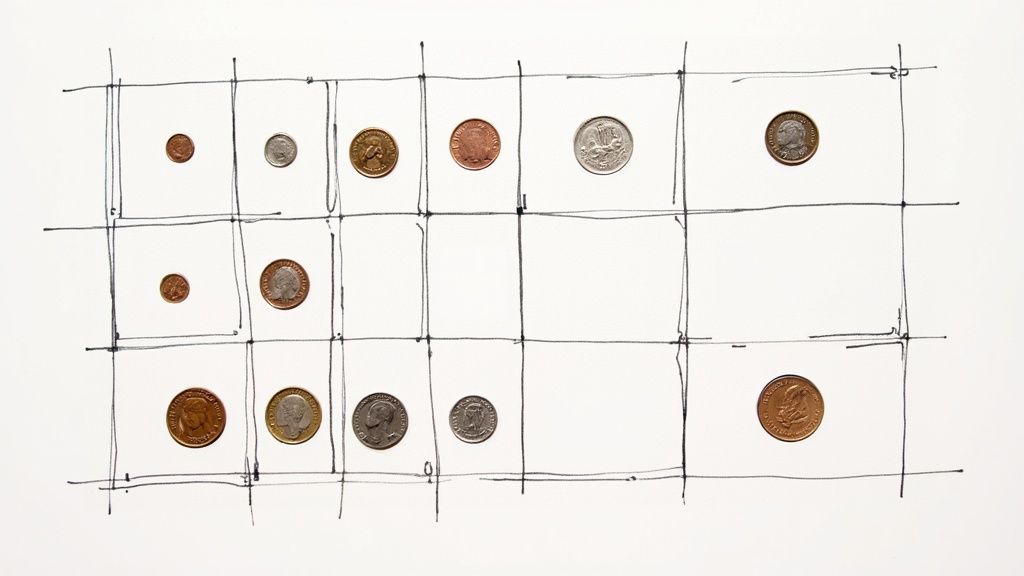Collecting British coins is more than just a hobby; it’s a way to hold over two thousand years of history, art, and culture right in the palm of your hand. It's an adventure that can start with the loose change in your pocket, offering a real, physical connection to the monarchs and moments that have shaped the nation. This guide is your starting point for this fascinating journey.
Why Start Collecting British Coins

Getting into British coin collecting is like becoming a guardian of history. Think of each coin as a tiny time capsule, a metal token that has passed through countless hands, witnessing the rise and fall of empires, the reigns of famous monarchs, and the evolution of a country. It’s a hobby that offers so much more than just accumulating objects; it gives you a profound connection to the past.
The appeal is in the sheer diversity and depth. You can literally trace the lineage of British rulers—from the early Anglo-Saxons right up to the modern Windsor dynasty—all through the portraits stamped onto their currency. The story of British coinage itself is ancient, with roots stretching back long before the Romans ever set foot here.
The very first coins showed up between the 4th and 2nd centuries BC, often as payments to mercenaries. But the first truly British-made coins, known as Potins, were cast in Kent around the 2nd century BC, kicking off a numismatic tradition that's completely unique. You can find more great insights on this early history over at paulfrasercollectibles.com.
The Thrill of the Hunt
Let’s be honest, one of the best parts of collecting is the "thrill of the hunt." Whether you're sifting through a jar of old pennies or browsing the tables at a specialist coin fair, the chance of stumbling across a rare or important piece is always there.
A coin might be valuable because of a low mintage, a strange minting error, or its link to a pivotal moment in history. This constant sense of potential discovery adds a real layer of adventure to the whole process.
For many collectors, it isn't really about the monetary value. It's about the satisfaction of completing a set, finding that one coin from a specific year, or owning a piece that tells a compelling story. Each new addition brings a sense of accomplishment and deepens your personal connection to Britain's rich heritage.
Key Eras in British Coinage History
To really get to grips with British coin collecting, you have to understand the stories these little metal discs tell. Every single coin is a product of its time, a tiny artefact shaped by everything from conquest and royal dramas to social upheaval and technological leaps. The journey of our currency is a long and winding one, starting centuries before the pounds and pence we recognise today.
The first truly massive shift came with the Romans. Before they arrived, Britain’s economy was a messy patchwork of local bartering and some limited use of Celtic coins. The Roman invasion after AD 43 changed all that, bringing the first standardised currency system to the entire land. Coins like the silver Denarii and bronze Sestertii suddenly made large-scale trade possible, and local coin production pretty much vanished for centuries.
This Roman system laid the foundations, but the story of British coinage is really defined by a few key moments of dramatic change. The infographic below zeroes in on three of the most important milestones.

As you can see, these weren't just minor tweaks. Each one was a fundamental overhaul of the whole monetary system, a direct response to the massive challenges of the day.
From Silver Pennies to the Gold Standard
Once the Romans packed up and left, the Anglo-Saxon kings started minting their own coins. It was the humble silver penny that emerged as the workhorse of the English economy right from the 8th century. That basic system of pounds, shillings, and pence would, incredibly, stick around for more than a thousand years. For a deeper dive into this fascinating period, you can check out our brief history of British coins.
Everything changed with the Napoleonic Wars. The immense cost of the conflict put Britain's currency under incredible strain. The answer was the Great Recoinage of 1816, a colossal effort to get the economy back on its feet. It's famous for officially putting Britain on the gold standard, launching the iconic gold Sovereign (worth one pound) and re-establishing a reliable silver coinage.
This recoinage was about more than just new money; it was a statement of Britain's economic power and stability on the world stage. It created the modern foundation of the pre-decimal system that would last for another 150 years.
The Great Change: Decimalisation
For modern collectors, the most profound change of all happened on 15 February 1971, a day forever known as "Decimal Day." On that date, Britain finally said goodbye to the wonderfully complex but maddening system of pounds, shillings, and pence (£sd). It was replaced by a much simpler decimal system where one pound equalled 100 "new pence."
The switch took a massive public education campaign and a whole new set of coins. For numismatists, it draws a clean, sharp line in the sand:
- Pre-Decimal Coins: Think Farthings, halfpennies, pennies, shillings, florins, and crowns.
- Decimal Coins: The familiar pence and pound coins we use every day.
Getting your head around these distinct eras is the key. It’s what helps you understand why a coin looks the way it does, what metal it’s made from, and where it fits into the grand story of Britain. It's the difference between just having a pile of old coins and being a knowledgeable collector.
How to Read a British Coin

Learning to 'read' a British coin is a bit like learning a new language. At first, the mix of portraits, symbols, and text can feel a little overwhelming, but every single element tells a part of the coin's story.
Mastering this skill is the true foundation of collecting British coins. It's what turns a simple piece of metal into a historical document you can actually hold in your hand.
Every coin has two faces. The obverse is what we call the 'heads' side, which almost always features the portrait of the reigning monarch. The reverse is the 'tails' side, where you'll usually find the coin's value or a special commemorative design. These are the two most basic parts of any coin's anatomy.
Think of these elements as a coin's vital statistics—they help you pinpoint its age, origin, and purpose. Getting comfortable with them is your first step towards confidently spotting interesting pieces for your collection.
Breaking Down the Key Features
Beyond just the heads and tails, several other features give you crucial information. Understanding what these are will seriously level up your ability to identify and appreciate any British coin that comes your way.
Let’s take a look at the main components you'll find:
- Portrait: This is the effigy of the monarch on the obverse. It's a long-held tradition that each new monarch faces the opposite direction of their predecessor.
- Legend or Inscription: This is the text that runs around the coin's edge. It usually includes the monarch's name and titles, often written in abbreviated Latin.
- Date: This is simply the year the coin was minted. You'll usually find it on the reverse, though sometimes it pops up on the obverse.
- Denomination: The face value of the coin (e.g., One Penny, Fifty Pence, One Pound). This is almost always displayed on the reverse side.
- Mint Mark: A tiny letter or symbol that tells you where the coin was made. While most modern UK coins are struck at The Royal Mint in Llantrisant, historically, coins were produced in London, Birmingham (the Heaton Mint used an 'H'), or even in mints overseas.
A fantastic example is the inscription you'll see on a modern coin for King Charles III:
CHARLES III · D · G · REX · F · D. This is Latin shorthand for "Charles III, by the Grace of God, King, Defender of the Faith." Spotting details like this helps you place the coin perfectly within its historical context.
From Shillings to Pence
The denominations of British coins have changed massively over time, especially with the huge shift to decimalisation back in 1971. If you're delving into older coinage, you'll need to get your head around the pre-decimal system.
Before 1971, the currency was based on pounds, shillings, and pence (£sd). You'll come across names that seem strange today, like the Farthing (a quarter of an old penny), the Shilling (worth 12 old pence), and the Florin (worth two shillings). Learning how these old denominations relate to each other is a key skill for collecting British coins from different eras.
This knowledge is what transforms you from a casual observer into an informed collector. You’ll soon be able to quickly identify a coin's monarch, its age, and its unique place in the long and fascinating history of British money.
Grading and Valuing Your Coin Collection
Figuring out what a coin is actually worth is one of the most rewarding parts of collecting. It’s a fascinating mix of science and art, where the smallest details can have a massive impact on value. The single most important factor is the coin's grade – which is just a fancy way of describing its physical condition.
A good way to think about it is like a condition report for a classic car. A vintage motor with its original paint job and zero scratches is going to be worth far more than the same model that's been driven hard for decades. Coins are no different. Two identical coins from the same year can have vastly different values based purely on how well they’ve been preserved.
In the UK, the grading scale runs all the way from 'Poor' (a coin that's very heavily worn) up to 'Uncirculated' (UNC), which is a coin in perfect, mint condition, looking just like it did the day it left The Royal Mint. It's a simple rule of thumb: a higher grade almost always means a higher value.
Understanding the Key Factors in Coin Value
While condition is king, it doesn't tell the whole story. Several other elements come together to determine a coin's final market price. Getting a handle on these will help you make much smarter decisions as you build your collection.
Beyond its physical grade, three main things drive a coin's worth:
- Rarity: This one is pretty straightforward. How many were made in the first place? A coin with a tiny mintage, like the famous Kew Gardens 50p, is naturally harder to find and, as a result, more sought-after.
- Collector Demand: A coin is only worth what somebody is willing to pay for it. Certain monarchs, themes, or periods in history are simply more popular than others. This can drive up prices for those coins, sometimes even if they aren't incredibly rare.
- Historical Significance: Does the coin mark a major event or represent a unique moment in time? Coins from very short reigns, or those struck during a war, often have that extra layer of story that collectors find irresistible.
A common penny from Queen Victoria's long and stable reign might only be worth a little in average condition. But find a penny from the blink-and-you'll-miss-it reign of Edward VIII, and you've found a major prize. So few were ever produced before his abdication that they are exceptionally rare and valuable.
Before we dive deeper, it's helpful to have a clear picture of what these grades actually mean. Here’s a quick breakdown of the main UK grading standards you'll encounter.
Understanding UK Coin Grading Standards
| Grade | Abbreviation | Description | Key Features to Look For |
|---|---|---|---|
| Uncirculated | UNC | A coin in perfect condition, with no signs of wear. It appears as it did when it left the mint. | Full original lustre. No scratches or marks are visible to the naked eye. All design details are sharp. |
| Extremely Fine | EF | A coin with only very light wear on the highest points of the design. Most of the original mint lustre is still visible. | Very minor friction on high points. Over 95% of detail is present. Lustre is strong. |
| Very Fine | VF | The coin has seen some circulation, with noticeable but light wear on the design's high points. | More details are worn (e.g., hair, crown jewels), but the main features are still clear. Some lustre might remain. |
| Fine | F | Shows considerable wear all over. The main design is still visible, but finer details are worn away. | The overall design is clear, but many of the finer points are flat. The lettering and date should still be legible. |
| Poor / Fair | P / F | The coin is heavily worn and damaged. The date and monarch may be difficult to identify. | The design is mostly flat. The date may be partially or completely worn away. Significant scratches or damage. |
This table is a great starting point, but remember that grading is subjective and takes time to master.
Making an Informed Assessment
Learning to grade accurately takes practice. You'll need to train your eye to spot the slightest hints of wear on a coin's high points, learn to judge the quality of the original mint lustre, and check carefully for any scratches or damage that could affect the grade.
When you combine this hands-on visual check with some research into mintage figures and current market prices, you'll be in a powerful position to understand your collection's true potential.
For anyone looking to take their knowledge a step further, there are plenty of great resources out there. For instance, you can learn more about how to value old British coins to really build your expertise. This will empower you to assess your own finds with confidence and make sense of the prices you see at coin fairs and online.
Sought-After and Collectible British Coins

What is it that turns a simple piece of metal into something a collector will treasure? It's usually a cocktail of rarity, an interesting backstory, or some unique quirk that sets it apart from the millions of identical coins minted alongside it.
Looking at some of Britain's most iconic coins is a great way to get a feel for what truly drives the hobby. You start to see what makes a coin tick, and why some pieces generate so much excitement.
Some of the most famous examples aren't ancient relics dug from the ground, but modern coins that people genuinely found in their loose change. They’re proof that a low mintage figure or a simple mistake at the mint can create a superstar coin practically overnight, often sparking a nationwide treasure hunt.
These finds prove that you don't always need to visit a museum to find a numismatic gem. Sometimes, they're hiding in plain sight, just waiting for a keen eye to spot them.
Modern Classics and Famous Errors
When you think of modern collectible coins, few capture the imagination quite like the 2009 Kew Gardens 50p. With an astonishingly low mintage of just 210,000, its built-in scarcity and beautiful design have made it the holy grail for many UK collectors.
Then you have the fascinating world of error coins, like the 1983 'New Pence' 2p. This coin was accidentally struck using an old, outdated inscription, creating an instant rarity. It’s these little slip-ups that can make a coin incredibly desirable.
Beyond these headliners, plenty of other coins have compelling stories that make them hot property for collectors:
- The 2002 Commonwealth Games £2 (Northern Ireland): Four different versions of this coin were released to represent each home nation. The Northern Ireland variant had the smallest production run, making it the scarcest and most sought-after of the set.
- The 1992/1993 EEC 50p: This larger, older-style 50p was struck to mark the UK's presidency of the European Council. Its low mintage, combined with the fact it was later withdrawn from circulation, made it an instant collectible.
These kinds of coins are perfect targets for anyone just starting out. They’re recent enough to be recognisable, but just scarce enough to provide the thrill of the hunt. They really bridge the gap between pocket change and serious numismatics.
Cornerstones of a Deeper Collection
For those looking to build a collection with more historical weight, certain coins serve as cornerstones. These are the pieces that represent pivotal moments in British history and are seen as essential additions for any serious numismatist.
A fantastic example is the 1847 'Gothic' Crown. It’s widely regarded as one of the most beautiful coins ever produced in Britain. Its incredibly intricate design, tied to the Victorian era's Gothic Revival, makes it a true piece of art you can hold in your hand.
Owning a coin like this is about more than just its monetary value; it's about possessing a tangible link to a specific period in the nation’s past. If you’re looking for more ideas on where to begin, you might find our guide to collecting coins in the UK helpful. By exploring these famous examples, you start to develop an eye for what makes a coin truly special.
Building and Preserving Your Collection
Now that you have a good handle on identifying and valuing coins, the real adventure can begin: building your own collection. The first question is always, "Where do I look?" The good news is, potential treasures are genuinely all around you, from the change in your pocket to the stalls at a local flea market.
Many of us get our start with ‘coin hunting’ – that is, simply sifting through the coins we get every day. It's a fantastic, no-cost way to get your hands on interesting commemorative designs or spot older dates. Once you've exhausted your wallet, think about visiting car boot sales, antique shops, or even building a relationship with a few reputable coin dealers. They're your best bet for authenticated, high-grade pieces.
Finding Your Focus
With over two millennia of British coins to choose from, just diving in without a plan can feel like you’re swimming in the open ocean. The best way to build a collection you'll be proud of is to give it a clear focus. Think of it as your roadmap; it will guide your purchases and research, stopping you from just ending up with a random pile of metal.
Loads of newcomers find it helps to start with a manageable theme.
- Focus by Monarch: You could try to collect one coin from every monarch in a specific dynasty, like the House of Tudor or the House of Stuart. It’s a classic for a reason!
- Focus by Denomination: Another popular route is picking one type of coin, like the shilling, and tracing how its design has morphed through history.
- Focus by Period: Or perhaps you could concentrate on a specific slice of time, like collecting coins from the Second World War or the long reign of Queen Victoria.
This kind of targeted approach makes the huge world of British coins feel much more achievable and, ultimately, more rewarding.
Protecting Your Investment
The moment you acquire a new coin, your role changes from hunter to curator. Looking after your collection properly isn't just a suggestion—it's absolutely essential for preserving the condition, beauty, and value of your coins for years to come. The golden rule is simple: handle your coins as little as you possibly can.
If you take away one piece of advice, let it be this: almost never clean your coins. Cleaning can completely strip away a coin's natural patina—the subtle, beautiful toning that develops over decades—and leave microscopic scratches. You could permanently damage its surface and erase over 90% of its value in an instant.
When it comes to storage, always use materials designed specifically for numismatics. Acid-free albums, 2x2 cardboard flips, or individual plastic capsules are all excellent choices. They'll protect your coins from fingerprints, moisture, and general environmental damage, making sure your little pieces of history stay pristine.
Common Questions About Collecting British Coins
As you dip your toes into the fascinating world of British coin collecting, you're bound to have questions. It's completely normal. Getting started can feel a bit overwhelming, but getting straight answers to the most common queries will give you the confidence you need to build your collection the right way.
Think of this section as your starter toolkit. We’ll tackle those nagging questions head-on, from building a collection without breaking the bank to the single biggest mistake new collectors make (hint: it involves cleaning). Our goal is to help you sidestep the common pitfalls and start making smart choices from day one.
How Do I Start Collecting on a Budget?
You don't need a fortune to start a coin collection—in fact, you can begin for free. The absolute best way to get started is by ‘coin hunting’. Simply get into the habit of checking your daily change. Keep an eye out for interesting commemorative designs, older dates, or even coins from UK territories like Gibraltar or the Falkland Islands that sometimes slip into circulation.
When you're ready to expand, car boot sales and flea markets are your next best friend. You can often pick up bags of mixed pre-decimal coins for just a few quid, which is a fantastic hands-on way to get familiar with Britain's older currency.
Pro Tip: To avoid feeling overwhelmed, focus on one affordable series to start. Collecting the various commemorative 50p coins is an incredibly popular and budget-friendly entry point before you dive into the deeper, more expensive waters of historical coins.
Should I Clean My Old Coins?
This is probably the most critical question for any new collector, and the answer is a firm, unwavering no. You should almost never, ever clean your coins. Over decades, or even centuries, a coin develops a natural toning on its surface called a ‘patina’. This isn't dirt; it's a part of the coin's history, and it's something seasoned collectors value highly.
Trying to "improve" a coin with polishes, chemicals, or even a soft cloth will strip this patina away and create countless microscopic scratches. This causes permanent damage and can obliterate a coin's value, sometimes by more than 90%. The only time you should even consider it is a gentle rinse in distilled water for loose dirt, but for anything potentially valuable, it's best to leave it completely untouched.
How Can I Tell if a Rare Coin Is Genuine?
As you move towards buying more valuable coins, authenticity becomes a huge concern. Fakes are incredibly rare for common, low-value pieces, but for the more sought-after coins, it's a real risk you need to be aware of.
Your safest bet is always to buy from a reputable dealer, especially one who is a member of a trade body like the British Numismatic Trade Association (BNTA). Members guarantee the authenticity of the coins they sell, giving you complete peace of mind. Over time, you can also train your own eye by studying the specific weight, metal, and fine details of genuine examples. But as the old saying goes, if a deal on a rare coin seems too good to be true, it almost certainly is.
At Cavalier Coins Ltd, we provide authenticated, high-quality coins for every level of collector. Explore our extensive selection of rare and fascinating pieces to find the next treasure for your collection. Visit us today at https://www.cavaliercoins.com.

